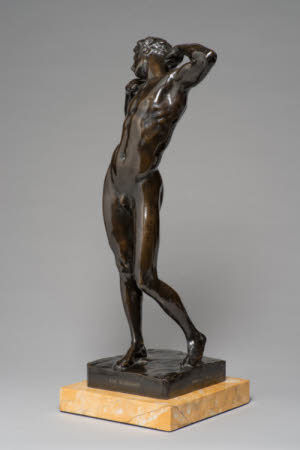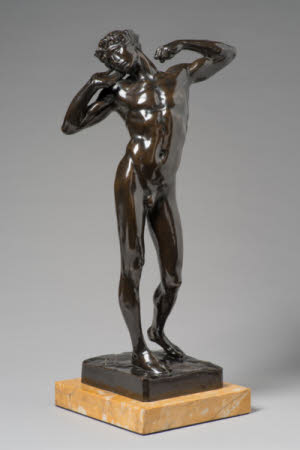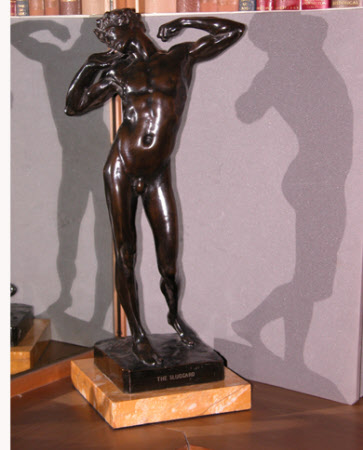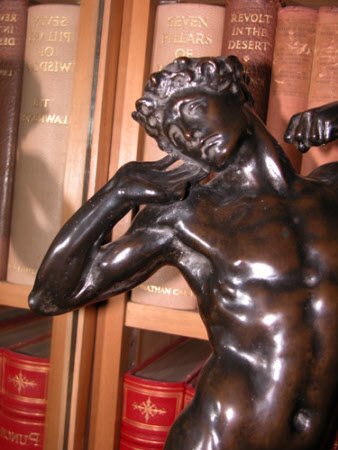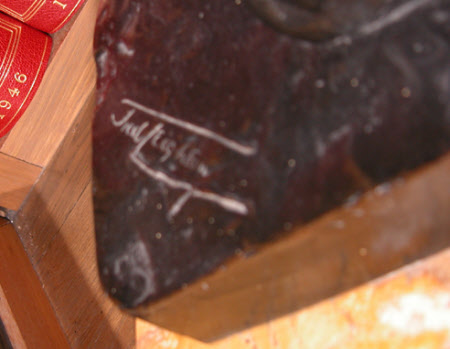The Sluggard
Sir Frederic Leighton, Lord Leighton PRA (Scarborough 1830 – Kensington 1896)
Category
Art / Sculpture
Date
1890
Materials
Bronze and marble
Measurements
512 x 250 mm
Place of origin
London
Order this imageCollection
Anglesey Abbey, Cambridgeshire
NT 515028
Summary
Bronze, The Sluggard, Frederic, Lord Leighton (1830-1896), 1890, signed 'Fred. Leighton', cast by J.W. Singer and Sons, Frome, Somerset. Published by Arthur Leslie Collie, London, 1890. Inscribed 'THE SLUGGARD' on bronze base; inscribed 'PUBLISHED BY ARTHUR LESLIE COLLIE | 39B OLD BOND STREET, LONDON, MAY 1ST 1890' on bronze base; inscribed 'FOUNDED BY J.W. SINGER AND SONS / FROME SOMERSET' on bronze base. A standing figure of a naked youth who twists his body as he stretches, his arms raised and his head tilted to the right. On an integral bronze base, set on a Siena marble base. Leighton’s Sluggard was exhibited at the Royal Academy in 1886. Small versions such as the one at Anglesey Abbey were published by Arthur Leslie Collie from 1890.
Full description
The Sluggard was conceived as a pendant to Frederic Leighton’s first sculpture, the Athlete wrestling with a python, exhibited in 1877, of which there is also an example at Anglesey Abbey (NT 515041). Indeed, its original title was the Athlete awakening from sleeping. However, the sculpture, with no obvious subject but imbued with a languorous naturalism, could not be more different in mood from the earlier bronze. The idea for the composition is said to have come to Leighton as he watched one of his models, Giuseppe Valona, stretching after a modelling session. But similar figures in the artist’s paintings from as early as the 1860s show that he had long been interested in this sort of contrapposto pose, in which one part of the body is consciously set in opposition to the other. The parallels between the pose of the Sluggard and Alfred Gilbert’s Perseus Arming (NT 515027), exhibited at the Grosvenor Gallery in 1882, are such as to make it conceivable that Gilbert’s sculpture was also a source for Leighton’s composition. Leighton was subsequently to commission the statue of Icarus from Gilbert. Leighton began work on the clay sketch model in the early 1880s and the full-size model, worked up in the studio of the sculptor Thomas Brock, had been completed by January 1886. A bronze cast of the full-size model was exhibited at the Royal Academy in 1886 and again in Paris in 1889, at the Exposition Universelle, where Leighton received a medal of honour for the work. The large bronze is today in the Tate collections. On the base of the large bronze behind the right foot, where Leighton’s signature appears in the smaller versions, there lies a laurel wreath, presumably cast away by the boy. Small versions of the model were being marketed from 1890 by Arthur Leslie Collie, who worked from the Bond Street premises of the dealer Thomas Agnew (Beattie 1983, p. 187), and whose bronzes were cast by the Singer foundry. The bronze figure was a successful and popular display piece in homes; a photograph in the Magazine of Art (1895, p. 372; Beattie 1983, p. 190, fig. 190) shows one of Collie’s casts displayed in the corner of a library room. Collie seems to have sold the copyright for these casts to the Foundry, which continued to market them up until at least 1914 (Beattie 1983, p. 260, note 59). These casts, for example one in the Ashmolean Museum, Oxford (Nicholas Penny, Catalogue of European Sculpture in the Ashmolean Museum. 1540 to the Present Day, 3 vols., Oxford 1992, III, p. 114, no. 533) lack Collie’s inscription but retain that for Singer. Casts such as that at Anglesey Abbey, with both inscriptions, are likely therefore to have been made between 1890 and c. 1906, by when Collie no longer appears in trade directories. Leighton’s tomb in St. Paul’s Cathedral (Benedict Read, Victorian Sculpture, New Haven/London 1982, pp. 329-31, fig. 392) was designed and executed by his friend and associate Thomas Brock (1847-1922). Brock modelled a version of The Sluggard which is held by the allegorical figure of Sculpture seated at the foot of the monument, but is also found in the form of independent statuettes (for one, see Leighton and his Sculptural Legacy, p. 35, no. 8). Jeremy Warren, 2018
Provenance
Purchased by Urban Huttleston Rogers Broughton, 1st Lord Fairhaven (1896-1966) after 1940; bequeathed to the National Trust by Lord Fairhaven with the house and the rest of the contents.
Credit line
Anglesey Abbey, The Fairhaven Collection (The National Trust)
Marks and inscriptions
On bronze base, at right, rear: Fred. Leighton (incised freehand into wax model) On bronze base, front edge: THE SLUGGARD On bronze base, rear edge: Published by Arthur Leslie Collie | 39b Old Bond St, London, May 1st. 1890. On bronze base, proper left edge : Founded by J.W. Singer and Sons | Frome Somerset
Makers and roles
Sir Frederic Leighton, Lord Leighton PRA (Scarborough 1830 – Kensington 1896), artist J. W. Singer and Sons, founder Arthur Leslie Collie (fl.1888 - 1897), seller
References
British Sculpture 1850-1914, exh.cat., The Fine Art Society, London 1968, p. 27, no. 101, Pl. E Beattie 1983: Susan Beattie, The New Sculpture, New Haven and London 1983, pp. 149-50, fig. 143, 187 Newall 1990: Christopher Newall, The Art of Lord Leighton, Oxford 1990, pp. 109-12, fig. 77 Jones 1996: Stephen Jones et al., Frederic Leighton. 1830-1896, exh.cat., venue: Royal Academy of Arts, London 1996, pp. 202-03, no. 93 Read and Kader 1996: Benedict Read and Alexander Kader, Leighton and his Sculptural Legacy. British sculpture 1875-1930, exh.cat., venue: Joanna Barnes Fine Arts, London 1996, p. 50, no. 20 Sir Alfred Gilbert and the New Sculpture: British Sculpture 1850-1930, exh.cat., venue: Fine Art Society in association with the Robert Bowman Gallery, London 2008, pp. 76-77 Alfred Gilbert, Frederic Leighton and the New Sculpture, exh. cat., venue: The Fine Art Society, London 2015, pp. 36-37, no. 7 The New Sculpture Movement: Searching for the Ideal, exh. cat., venue: Bowman Sculpture, London 2018, pp. 8-11


